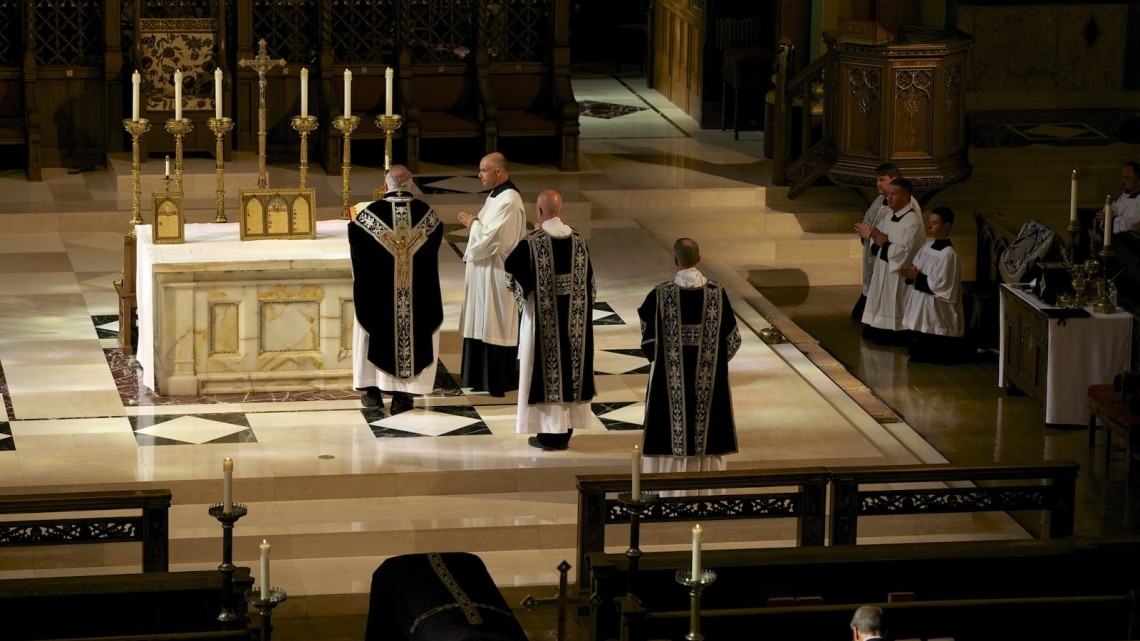I generally avoid liturgical questions, but I think that the options that relate to today’s celebration provide a unique opportunity to explore different ways of approaching death. In the wake of the Second Vatican Council, one area in which there was a marked shift was in the celebration of All Soul’s Day. Before the Council, the custom had been to celebrate today’s Mass wearing black. After the Council, the custom became to use the color white. Currently, priests have three options: violet, white, or black.
The use of the color white was meant to highlight the importance of the Resurrection in our understanding of death. A popular notion that accompanied this thinking was that we are a “Resurrection people” and “Alleluia is our song.” I may not be the most capable person to provide a thorough analysis of changes that I was not alive to see, but I can speak at least to my own childhood and the ripple effects that such thinking had on my faith life.
My generation is mostly the result of an age in which good self-esteem and positive thinking was the norm. While there were many benefits to such thinking, one of the unintended consequences was that the culture seemed to undervalue the role of suffering. It was not surprising that a feel good and overly optimistic culture would swing so dramatically in the 90’s and produce an artistic culture that was known for almost the complete opposite. In place of high ideals and utopian expectations, the music of my generation had a kind of fatalistic nihilism.
In terms of spirituality, there seemed to be a growing trend in which religion became reduced to good feelings. The point was to feel connected and to have an experience that validated our sense of being loved and cared for. When taken to an extreme, this spirituality can have many negative effects which hinder true devotion and a truly realistic emotional intelligence. That being said, there were also many beautiful benefits that came from a spirituality that provided a place for sentiment and affectivity.
When I think of white vestments in connection with All Souls Day, I kind of associate them with these notions which come from my childhood. In contrast, I tend to associate black vestments with an aspect of Catholicism that I am coming to appreciate more and more each day.
We all must come to the place where we face the reality of death and judgment. As essential as hope is to our spiritual journey, to come to experience a hope that moves deeper than surface emotion, we must allow ourselves to face the fear and suffering that comes with death. In addition, we must avoid the temptation of condemning the discomfort that comes with mourning and distress. It is okay to suffer at the death of a loved one, and such suffering does not indicate a lack of faith.
True holiness is found in holding the two extremes in tension, embracing both white and black. Or perhaps, by seeing both ideals, we must also come to appreciate that life is not as simple as black and white. With such an outlook, we learn to move beyond simple definitions and easy answers, and instead of theology become a collection of stale ideas; it becomes a living encounter with God that moves us beyond our limited patterns of thinking.











Perhaps a white vestment with black embroided trimming would address both options.
Haha… maybe. I am proud that our sacristan replied!
In my parish we have a very old black cope and stole together, after Mass I suggested to the Priest to wear it for the blessings of the grave; I was then branded by the Bishop who was also there that day as a “young traditionalist”; later on we discussed and I said that the colour is not being about a traditional or not, its the significance of the colour that black signifies.
The black vestments already have this tension in them-they are almost always trimmed in silver or gold-liturgical equivalents to white. Death, by its nature, should be mourned (black) but our Christian hope (silver/gold) impels us to pray for the Poor Souls and comforts us with the thought that we can be reunited with them again.
Aside from the missionary pastoral concerns (colors don’t have the same meaning everywhere), I see white vestments for funerals and All Souls as a sort of subtle universalism. All of the Concilium members would have been familiar that the tradition was that only baptized infants and children before the age of reason we’re given a “white funeral” with the Missa de Angelis instead of a black Requiem. Changing that may not seem like a big deal now, but the message was pretty clear then.
Learned something new. Thanks